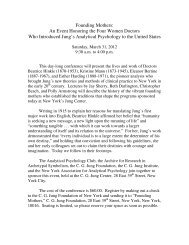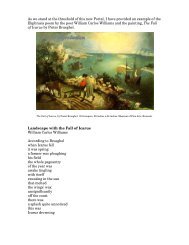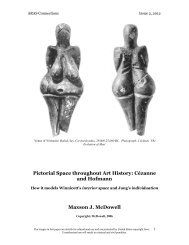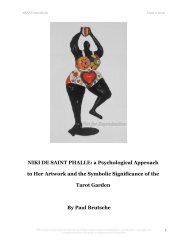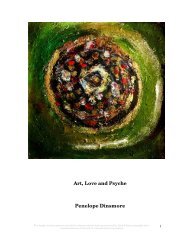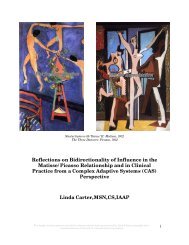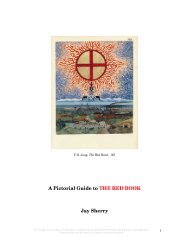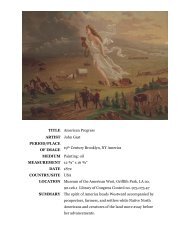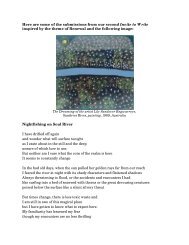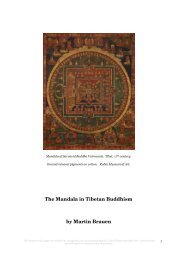THE MIRROR OF ART: REFLECTIONS ON ... - ARAS
THE MIRROR OF ART: REFLECTIONS ON ... - ARAS
THE MIRROR OF ART: REFLECTIONS ON ... - ARAS
You also want an ePaper? Increase the reach of your titles
YUMPU automatically turns print PDFs into web optimized ePapers that Google loves.
<strong>THE</strong> <strong>MIRROR</strong> <strong>OF</strong> <strong>ART</strong>: <strong>REFLECTI<strong>ON</strong>S</strong> <strong>ON</strong><br />
TRANSFERENCE AND <strong>THE</strong> GAZE <strong>OF</strong> <strong>THE</strong> PICTURE<br />
Joy Schaverien<br />
The images in this paper are strictly for educational use and are protected by United States copyright laws.<br />
Unauthorized use will result in criminal and civil penalties.<br />
1
Cognition, language, myth and art: none of them is a mere<br />
mirror simply reflecting images of inward or outward data; they<br />
are not indifferent media, but rather true sources of light, the<br />
prerequisite of vision, and the well-springs of all formation.<br />
(Cassirer 1955a, p. 93)<br />
This presentation (given at the Art and Psyche conference in San<br />
Francisco, 2008) is about art and its formative nature. To be clear about the title,<br />
I am not suggesting that art is a mirror in the sense of a cold or flat reflection.<br />
Rather, within analysis, art reveals and so reflects the multi-layered contents of<br />
the psyche and presents them for the gaze. It is the irreducible, non-discursive<br />
role of pictures that is psychologically transformative and so, within analysis, art<br />
offers a very particular means of mediation. The making of art may lead to<br />
confrontation with shadow elements of the unconscious, revealing mythical or<br />
archetypal images as well as their underlying psychological states. Thus<br />
Contemporary Developmental and Classical Jungian approaches to<br />
understanding individuation converge in “the field of vision.”<br />
Two Aspects of Art within Analysis<br />
There are two different stages related to image making and the viewing of<br />
pictures within analysis. These I have called “the life in the picture” and ”the life<br />
of the picture” (Schaverien, 1992). ”The life in the picture” relates to the imagery<br />
that is revealed in the art work, whilst “the life of the picture” refers to the effects<br />
of its continued existence as an object in time and space. The first stage, the<br />
making of the picture, uncloaks images, previously experienced only as unformed<br />
sense impressions or transient mental imagery, and presents them for the gaze of<br />
the artist. In viewing the picture there is a gradual “dawning of consciousness” as<br />
shadow elements are brought into the light. Although a picture is not a mirror<br />
The images in this paper are strictly for educational use and are protected by United States copyright laws.<br />
Unauthorized use will result in criminal and civil penalties.<br />
2
eflection it does, in another sense, mirror aspects of the psyche. Moreover its<br />
enduring existence offers an opportunity for becoming reconciled to these<br />
elements over time. Viewing pictures may lead to mythical associations,<br />
cognition, and eventually to language and the ability to speak of previously<br />
unspeakable states. In such cases the eyes play a significant part in the process of<br />
individuation.<br />
Consciousness – Jung and Cassirer<br />
Jung’s respect for the images of the unconscious was profound. This often<br />
quoted passage from the Psychology of the Transference forms a background to<br />
our understanding consciousness.<br />
Consciousness… must always remain the smaller circle within<br />
the greater circle of the unconscious, an island surrounded by the<br />
sea; and, like the sea itself, the unconscious yields an endless and<br />
self replenishing abundance of living creatures, a wealth beyond<br />
our fathoming. We may long have known the meaning, effects<br />
and characteristics of unconscious contents without ever having<br />
fathomed their depths and potentialities, for they are capable of<br />
infinite variation and can never be depotentiated. The only way<br />
to get to them in practice is to try to attain a conscious attitude<br />
which allows the unconscious to co-operate instead of being<br />
driven into opposition (my emphasis).<br />
(CW16, para. 366, )<br />
Pictures illustrate some of these “living creatures” that may be present but<br />
unseen in other forms of analysis. This conference, and the papers we have<br />
already seen and heard, makes it clear that most of us here are convinced that art<br />
is psychologically transformative. Therefore my interest is not merely to show<br />
that this happens but to offer ways of developing thinking about how and why<br />
The images in this paper are strictly for educational use and are protected by United States copyright laws.<br />
Unauthorized use will result in criminal and civil penalties.<br />
3
that might be. What are the processes involved in the making and viewing of art<br />
works? How does the therapeutic relationship influence and mediate the<br />
processes of image making and viewing?<br />
I turn to Cassirer, who had much in common with Jung and, yet, they<br />
never met, (Avens, 1980). Although Cassirer (1957, p. 93) was not writing of art,<br />
or of the individual psyche, his elucidation of the development of consciousness<br />
in culture is applicable for the very personal developmental processes of analysis.<br />
He traced a progression from concrete or undifferentiated thinking, through<br />
myth, the making and use of tools to other less practical material objects such as<br />
religious artefacts. This leads to differentiated consciousness, symbolisation and<br />
ultimately to language.<br />
Art in analysis can be viewed in a similar way. The picture is a material<br />
object, created in the interest of expressing some unarticulated aspect of the<br />
psyche. It brings shadow elements into the light and so a conscious attitude,<br />
(Schaverien, 1992). Cassirer, like Jung, made a connection with alchemy which<br />
he calls a “semi mythical science of nature” (1955b, p. 66). The thought processes<br />
implicit in alchemy are similar to those found in the analysand’s relationship to<br />
pictures. This is because in art the psyche is mediated through material<br />
substances; we mix pigments, draw in charcoal or pastels, mould clay and so<br />
chemicals are brought together to create something new. Jung’s work on<br />
alchemy has of course been influential in my thinking about this. However with<br />
regard to the transference particular to art within analysis I was drawn to a brief<br />
passage from the volume of The Philosophy of Symbolic Forms where Cassirer<br />
writes:<br />
The images in this paper are strictly for educational use and are protected by United States copyright laws.<br />
Unauthorized use will result in criminal and civil penalties.<br />
4
All alchemic operations, regardless of their individual type have<br />
at their base the fundamental idea of the transferability and<br />
material detachability of attributes and states – the same idea<br />
which is disclosed at a more naïve and primitive stage in such<br />
notions as that of the scapegoat.<br />
Cassirer (1955b, p. 66)<br />
The art object made in the analytic context is subject to a particular type of<br />
“transferability and material detachability of attributes and states” (Schaverien<br />
1992:42). In the Jewish tradition, at Yom Kippur, the scapegoat is transformed<br />
through ritual into an embodiment of the sins of the community and is<br />
understood to take them away. Thus in the disposal of the scapegoat the sins are<br />
expiated. As Cassirer points out this is “a real physical transference not a<br />
symbolic substitution.” It is concretely experienced rather than a symbolic act. It<br />
is similar with pictures, which are sometimes experienced by their maker as live<br />
and they are not merely symbolic but concretely imbued with affect. They too<br />
may be experienced as objects of a transference of attributes and states and so<br />
transformed into an embodiment of affect. Thus, art in analysis works similarly<br />
to the scapegoat and forms what I have called ‘the scapegoat transference’<br />
(Schaverien 1992, pp. 30-61.<br />
The Scapegoat Transference<br />
Pictures viewed in the analytic context might be seen as an embodiment of<br />
such attributes and states. Thus for the artist they have a formative function. A<br />
picture may “uncloak” an image of which the artist had previously only a vague<br />
sense impression. Once pictured, the image is “out there” rather than internal.<br />
As a result of this, even without verbal interpretation, transformation begins to<br />
take place in the inner world of the artist. The picture, by embodying a<br />
The images in this paper are strictly for educational use and are protected by United States copyright laws.<br />
Unauthorized use will result in criminal and civil penalties.<br />
5
transference, creates a space between the image and the act. The picture is its<br />
own interpretation.<br />
The Mirror<br />
In considering the effects of the gaze of the picture on the artist as viewer<br />
of his or her own work it is relevant to turn briefly to two European<br />
psychoanalysts, Winnicott (1967) and Lacan (1949), who both contribute to<br />
analytic thinking about mirroring. Winnicott’s interest was in the effects, on<br />
psychological growth, of the ways in which an infant is cared for in the early years<br />
of life and, the emotion reflected in the mother’s eyes. The baby looks at the<br />
mother and what s/he sees there contributes to how s/he feels about her/himself.<br />
Thus if s/he meets a loving gaze s/he feels lovable but if the gaze is depressed or<br />
distracted, s/he may feel guilt or unlovable. Such early emotional experiences<br />
very often remain active, influencing interpersonal relationships throughout life.<br />
Like Winnicott’s mirroring mother, the gaze of the artist rests in his own picture<br />
and in this his existence is affirmed. Pictures feedback to the artist, confirming a<br />
feeling state and, similar to the mother’s gaze, the picture is the result of reverie,<br />
emotional investment and it reflects the self state.<br />
Lacan suggests that the moment the infant sees his reflection in a mirror<br />
s/he becomes aware of the objective gaze, the gaze of the other. This is the<br />
moment of recognition of his status as a separate being (1949, p. 3-4). We might<br />
here see a parallel with the picture that presents for the gaze, not the outer image<br />
of the person, but the emotional state. Like Lacan’s mirror pictures offer an<br />
aspect of separation and differentiation from a fused state. The experience of<br />
being is reflected in the marks the artist makes and a subjective state is<br />
objectified.<br />
The images in this paper are strictly for educational use and are protected by United States copyright laws.<br />
Unauthorized use will result in criminal and civil penalties.<br />
6
Fordham’s (1976, p. 16) Jungian perspective was to consider that the<br />
infant self was in existence from the start of life. His close observation of infants<br />
led to the theory of integration and de-integration. For Fordham the baby is an<br />
integrated self from the beginning and, as he develops, he de-integrates, moving<br />
towards the maternal environment to take from it what he needs, returning to<br />
sleep to integrate the experience. This process too continues throughout life. The<br />
picture offers a de-integrate for the gaze of the artist and, following a period of<br />
integration, a further separation - differentiation occurs.<br />
The idea is that a picture, as it unfolds or reveals itself, becomes its own<br />
interpretation and so no words are needed. The process reflects back to the gaze<br />
of its maker, offering a gradual dawning of consciousness. Not all pictures offer<br />
this opportunity; it is a result of the effects of the ‘life in the picture’.<br />
The life in the picture - Two types of “image”<br />
The idea that a picture embodies meaning is derived from aesthetic theory<br />
and particularly Suzanne Langer, who was both a student of Cassirer and his<br />
translator. She writes:<br />
Non discursive form in art…articulates knowledge that cannot be<br />
rendered discursively because it concerns experiences that are<br />
not formally amenable to discursive projection.<br />
(Langer, 1967, p. 240)<br />
Langer draws attention to imagery which is merely embellishment. This is<br />
like the design around the edge of a plate, which signifies the edge of the plate;<br />
such imagery is not “significant form”’, it is “significant motif.” Genuine art is<br />
profoundly symbolic and the picture is an irreducible entity, which she calls the<br />
“art symbol.” This is different from the symbols in pictures. I have developed<br />
The images in this paper are strictly for educational use and are protected by United States copyright laws.<br />
Unauthorized use will result in criminal and civil penalties.<br />
7
this, and following Arnaud Reid (1969), called it “the embodied image<br />
(Schaverien 1992).”<br />
A distinction is needed between art that is formative in the true sense and<br />
art that is functional. This relates to its symbolic depth. I have differentiated<br />
between those images that merely signify and those which are profoundly<br />
symbolic. The distinction is made on the basis of considering the aesthetic effects<br />
of pictures. In analysis there are times when a person wants to describe a<br />
situation, maybe something that happened long ago, or maybe something that<br />
shows a sequence of events. In that situation the analysand makes a picture to<br />
tell something to the analyst.<br />
The Diagrammatic Image<br />
This is what I have called a diagrammatic image<br />
(Schaverien, 1987, 1992). It is descriptive, usually linear, and<br />
the point about it is that, in its making, it changes nothing in<br />
the psyche of its maker. Its aesthetic quality is limited. This<br />
Figure 1 I feel<br />
sad.<br />
image is not formative in itself; in the process of its making it changes nothing. It<br />
is functional, made for a conscious purpose – it is made to tell something to the<br />
analyst. Even if such a picture leads to unconscious associations it does not<br />
reveal the depth psychological situation. Such a picture needs words to embellish<br />
its meaning and sometimes the analysand might write words on their picture. In<br />
hierarchical terms such an image is of poor aesthetic quality – it embellishes the<br />
spoken word and the spoken word embellishes it - but it does not engage the gaze<br />
of either its maker or the analyst viewer. It is more like a house on a map; it<br />
refers to something outside of itself. This is different from the embodied image.<br />
The images in this paper are strictly for educational use and are protected by United States copyright laws.<br />
Unauthorized use will result in criminal and civil penalties.<br />
8
The life in the Picture – the Embodied Image – Symbolisation<br />
Embodiment begins with the analysand who is moved to use the art<br />
materials to attempt to externalise pressure from images that can find no other<br />
mode of expression. Led on by a half formed sense impression, s/he makes a<br />
mark on paper or in clay. This first unspecific mark leads on to another and, as<br />
this process develops, image making takes over. The process begins to lead and<br />
have its own momentum. If there is no conscious attempt to depict the image<br />
that is in the mind, the picture leads the eye and the hand onwards. The<br />
engagement in the process at this point is total. The artist is totally identified<br />
with the image in the process of its creation.<br />
The Embodied Image<br />
Like the “art symbol” the embodied image is one that cannot be reduced to<br />
its parts. Thus it is not about symbols in pictures but about the whole work as an<br />
irreducible entity. Words may embellish such a picture but they cannot be<br />
substituted for it. Unlike the diagram, which needs the elaboration of the spoken<br />
or written word, the embodied image is not immediately amenable to discourse.<br />
While the diagrammatic image usually stays within known territory, the<br />
embodied image transcends what is consciously known. It develops from a<br />
combination of selective attention and inattention (Harrison, 1978); thus the act<br />
of painting takes precedence over the original sense impression or mental image.<br />
Even when there was a preconceived aim, the picture develops in unexpected<br />
ways and usually takes a form, which could not have been predicted and so it<br />
surprises its maker.<br />
The images in this paper are strictly for educational use and are protected by United States copyright laws.<br />
Unauthorized use will result in criminal and civil penalties.<br />
9
The Embodied Image<br />
If we regard this picture I<br />
think you will agree that no words<br />
could replace it. It is profoundly<br />
symbolic. This articulation could<br />
take no other form, no other mode of<br />
expression. This is the first picture<br />
in the series that I will show today.<br />
The gaze of the picture engages the<br />
viewer and, of course, the first<br />
viewer of any picture is the artist<br />
who made it. The image is no simple<br />
mirror of an inner world state but rather it conveys it through a powerful form of<br />
embodiment.<br />
Figure 2 The Bubble<br />
This picture was made by a young man suffering from anorexia. (For the<br />
whole history, see my book Desire and the Female Therapist: Engendered gazes<br />
in Art Therapy and Psychotherapy, Routledge 1995). The points I want to draw<br />
out here are related to the way in which, at times, pictures embody a form of<br />
transference themselves and echo the transference to the analyst. In<br />
developmental terms we might see this image as depicting the psychological<br />
situation; trapped within the womb, the body has atrophied. In the picture we<br />
see a body without substance or sexual characteristics. It is indeed a deathly state<br />
and the gaze of the picture is deathly; one from which the viewer might recoil.<br />
Art presents for the gaze – for the eyes – images that may be half formed<br />
and seen only initially in the mind’s eye. In presenting images in pictorial form,<br />
The images in this paper are strictly for educational use and are protected by United States copyright laws.<br />
Unauthorized use will result in criminal and civil penalties.<br />
10
those which have been experienced only as sense impressions or dream residues<br />
are transformed, given an external form. Thus it is that consciousness emerges<br />
and that gradually the “‘I’ comes to grips with the world” (Cassirer, 1955).<br />
Figure 3 The Castle<br />
This picture, made within a few days<br />
of previous one, might be seen to show a very<br />
similar situation but less literal. A dream-like<br />
image of a castle surrounded by a moat and<br />
covered in cobwebs depicts a very similar<br />
state. In this series the position of the sun is<br />
significant. Here it is behind the castle and<br />
the path is circular. Like the bubble there is<br />
no access: no way of entering or exiting and<br />
the drawbridge is raised. There is also a deep<br />
precipice between the castle and viewer. Like the atrophied figure in the bubble<br />
it reveals, in symbolic terms, a trapped situation. The cobwebs that are draped<br />
over it might be seen to echo the maternal<br />
nature of this castle and its inaccessibility.<br />
This was confirmed in the picture of the<br />
Madonna mother with cobwebs in picture 4.<br />
This idealised image of a Madonna he said was<br />
his mother. However the idealisation is<br />
tempered by the spiders’ webs. The spider is<br />
often thought of as symbolic of the mother. This<br />
image embodies a psychological situation for<br />
which no words could be substituted.<br />
Figure 4 Mother<br />
The images in this paper are strictly for educational use and are protected by United States copyright laws.<br />
Unauthorized use will result in criminal and civil penalties.<br />
11
The Embodied Image – The Art Symbol<br />
The embodied image such as this embodies meaning<br />
It embodies a form of transference<br />
It is not about symbols in pictures but the art object as an<br />
irreducible entity<br />
The Transference Revealed<br />
The transference to the analyst in the traditional Freudian or Jungian<br />
sense was revealed in a picture given to me by the analysand very early in his<br />
analysis. He made it at the same time as the bubble picture.<br />
Figure 5<br />
At this stage in the analysis the analysand was regressed and he made this<br />
picture, which is my name made out of positive elements; the sun, a tree, the<br />
moon and stars. The masculine principle was projected; the maternal principle<br />
was experienced at this time as a trap. He was unable to move. If we view this<br />
picture in conjunction with the one that he made next we can see more clearly<br />
how his idealisation of women, and his mother in particular, was a point at which<br />
he was arrested. Unable to claim his masculinity he had retreated to being his<br />
mother’s child; but this was an unsatisfactory psychological situation.<br />
The images in this paper are strictly for educational use and are protected by United States copyright laws.<br />
Unauthorized use will result in criminal and civil penalties.<br />
12
As this series progresses we see that this<br />
is the state prior to separation differentiation. In<br />
the next picture a gradual separation begins to<br />
take place. This is an image of mirrors and, as<br />
someone who suffered from an eating disorder,<br />
his body image was distorted. As he begins the<br />
journey of separation he looks along a dangerous<br />
precipice road. The sunshine – the masculine<br />
principle is behind him as if permeating his body<br />
Figure 6 Birth<br />
–perhaps warming it. The solar colours, the<br />
masculine principle, and light that were<br />
previously identified with the analyst in the<br />
picture of her name (picture 5), are now his<br />
own.<br />
The life of the picture<br />
Now I would like to pause and consider<br />
the processes involved in this series of<br />
pictures, by turning to what I have called the<br />
life of the picture. While dreams and most other analytic phenomena are<br />
transient, the art object continues to exist; it reflects back to its maker. It<br />
presents an object for the gaze to engage with while cognition catches up. I have<br />
identified the following stages in the artist’s relation to his or her own art works.<br />
Terms borrowed from Cassirer’s (1955) discussion of the evolution of<br />
consciousness in culture are shown in quotation marks.<br />
Figure 7 Body Images<br />
The images in this paper are strictly for educational use and are protected by United States copyright laws.<br />
Unauthorized use will result in criminal and civil penalties.<br />
13
Identification This is the state of the artist immediately<br />
after the picture is made; “the phenomenon is bared” and the artist<br />
contemplates the picture. At this stage, the artist attached to his or her<br />
picture by the gaze and words can rarely add to the experience.<br />
Familiarisation. The picture is viewed and begins to<br />
become familiar. The artist begins to understand the “immanent<br />
articulation” of the picture. The picture is now seen as outside and so this<br />
is the beginning of differentiation. Because the articulation is immanent –<br />
visual – words or verbal interpretations are rarely helpful at this point and<br />
might well be experienced as intrusive.<br />
Acknowledgement. The artist now begins to consciously<br />
acknowledge the implications of the picture: “the dawning of<br />
consciousness” as the artist might speculate about other possible,<br />
previously unconscious, aspects of the picture. In analysis this is likely to<br />
be explored in discussion with the therapist and so words and even<br />
interpretations may help.<br />
Assimilation. This is the stage of re-integration of the<br />
material: the implications of the imagery, its psychological impact and<br />
dawning of conscious meanings are gradually assimilated. This is an<br />
additional contemplative stage and so it takes place between the artist and<br />
the picture and so words are again unlikely to be needed. This is the stage<br />
of living with the picture and may continue for some days, weeks or even<br />
in some cases years.<br />
The images in this paper are strictly for educational use and are protected by United States copyright laws.<br />
Unauthorized use will result in criminal and civil penalties.<br />
14
In the next picture (8) the battle to separate from the mother begins in<br />
earnest; the inner world state is powerfully uncloaked. His own words – added<br />
later – embellish this embodied image. At the time it was made all we could do,<br />
he as the artist and I as analyst, was to regard this image and silently<br />
acknowledge its powerful multi -layered meanings.<br />
Figure 8 The death of the child.<br />
As the separation of the diverse aspects of the self continues, a dangerous<br />
state is revealed in this picture. Even though there is regression during this<br />
phase, it is notable that a form of separation is taking place.<br />
The images in this paper are strictly for educational use and are protected by United States copyright laws.<br />
Unauthorized use will result in criminal and civil penalties.<br />
15
Figure 9 The Hero<br />
This image is a relief in contrast to some of the earlier ones . Now, as he<br />
was gaining weight physically, he was also gaining weight psychologically and<br />
emotionally. I see this as a rebirth image. In it we see a hero figure who stands<br />
facing the sun and holding a sword in his hands. We might see this as revealing a<br />
change in his psychological state; his sexuality and life force are accessible. He<br />
commented that previously the sword would have been turned inwards. It seems<br />
as if the mound on which he stands symbolises the rebirth from the maternal/<br />
earth body. This too can be seen as a developmental state expressed in powerful<br />
archetypal imagery. This is very different from the bubble picture (Picture 2),<br />
where the deathly figure was trapped as if in the womb. Now we witness a<br />
profound psychological change. We have observed a battle with his own psyche,<br />
which has led him to be able to engage in life.<br />
The images in this paper are strictly for educational use and are protected by United States copyright laws.<br />
Unauthorized use will result in criminal and civil penalties.<br />
16
This image is also about<br />
separation differentiation.<br />
Various elements that have<br />
been seen before are now, a<br />
year later, evident. The castle<br />
is reminiscent of the earlier<br />
castle (Picture 2) surrounded<br />
by a moat and cobwebs. Now,<br />
rather than this trapped<br />
unconscious state, it reveals a conscious light one. The castle is flooded with light<br />
and all the elements that were projected onto the analyst, in the picture of my<br />
name (Picture 5), are owned. The projected elements of the idealised<br />
transference are beginning to be assimilated and owned. The unconscious state<br />
is transformed to a conscious awareness.<br />
Life of the Picture - Disposal<br />
The final stage of the Life of the Picture is disposal. If there is a material<br />
object some decision needs to be arrived at as part of the termination of analysis.<br />
What happens to the art work? This needs to be worked through, thought about<br />
and a conscious decision made.<br />
Figure 10 The Sun<br />
Disposal. This is a direct result of the previous stages.<br />
Some embodied images become empowered in the process of their<br />
making; and, as I have elsewhere discussed, such pictures become<br />
talismans, holding magical power for the artist. This is additionally so<br />
when there is an intense transference within the therapeutic relationship.<br />
The disposal of the picture is the last stage of the process and it is<br />
The images in this paper are strictly for educational use and are protected by United States copyright laws.<br />
Unauthorized use will result in criminal and civil penalties.<br />
17
Conclusion<br />
dependent on the investment made by the artist in the object. Some<br />
pictures lose their power once the implications of the image have been<br />
consciously assimilated; others continue to be empowered long after the<br />
termination of analysis.<br />
I hope to have shown how these pictures reveal a process in which the<br />
making of art was formative in the emergence of consciousness. As the<br />
externalisation of internal images brings into the light elements that were<br />
previously in the shadow, a transformation takes place in the psychological state<br />
of their maker. Thus, although a picture is not a mirror reflection, such pictures<br />
do mirror elements of the psyche, revealing them to the artist in an acceptable<br />
symbolic form. There is a powerful psychological mirroring function in these<br />
pictures; they reveal the life and death battle that is sometimes the stuff of an<br />
analysis but this is not “mirror image.” They are a reflection of the changing state<br />
of the inner world situation. It is imperative that such states are mediated<br />
because they have the capacity to tear the person apart. The gaze of the pictures<br />
is compelling for the artist/ analysand and the analyst/ viewer. The pictures are<br />
a form of visual interpretation where words are for a time unnecessary. Viewing<br />
of pictures subsequent to their making leads to cognition, and eventually to<br />
language and the ability to speak of a previously unspeakable state.<br />
Note<br />
The pictures shown here are extracted from a fuller series from Desire and<br />
the Female Therapist: Engendered Gazes in Psychotherapy and Art Therapy<br />
The images in this paper are strictly for educational use and are protected by United States copyright laws.<br />
Unauthorized use will result in criminal and civil penalties.<br />
18
Published by Routledge 1995 and reprinted here with kind permission of the<br />
publisher.<br />
More detailed analysis of the pictures within the transference and the<br />
patient’s own words are to be found in that book.<br />
References<br />
Robert Avens (1980). Imagination is Reality. Dallas Texas: Spring.<br />
Ernst Cassirer (1955 & 1957). The Philosophy of Symbolic Forms 3 Volumes,<br />
New Haven: Yale University Press.<br />
Fordham, M. (1976). The Self and Autism in Volume 3 of “The Library of<br />
Analytical Psychology,” London: Heinemann.<br />
Jung, C.G. (1946). The Psychology of the Transference, CW 16.<br />
Jacques Lacan (1977). “The mirror stage as formative of the function of the I as<br />
revealed in psychoanalytic experience” in Ecrits: a Selection. London:<br />
Routledge and Keegan Paul.<br />
Langer, Suzanne (1957). The Problems of Art. London: Routledge and Keegan<br />
Paul.<br />
Reid, L.A. (1969). Meaning in the Arts, London: Allen and Unwin.<br />
Schaverien, Joy (1987). “The Scapegoat and the Talisman: Transference in Art<br />
Therapy” In Images of Art Therapy. Eds. Dalley, Schaverien, et al, London<br />
and New York: Routledge.<br />
_____. (1992; 1999). The Revealing Image: Analytical Art Psychotherapy in<br />
Theory and Practice. London & Philadelphia: Jessica Kingsley<br />
Publishers.<br />
The images in this paper are strictly for educational use and are protected by United States copyright laws.<br />
Unauthorized use will result in criminal and civil penalties.<br />
19
_____. (1995). Desire and the Female Therapist. London and New York:<br />
Routledge.<br />
Donald W Winnicott (1971). “The mirror-role of mother and family in child<br />
development” in Playing and Reality. London: Penguin.<br />
The images in this paper are strictly for educational use and are protected by United States copyright laws.<br />
Unauthorized use will result in criminal and civil penalties.<br />
20



